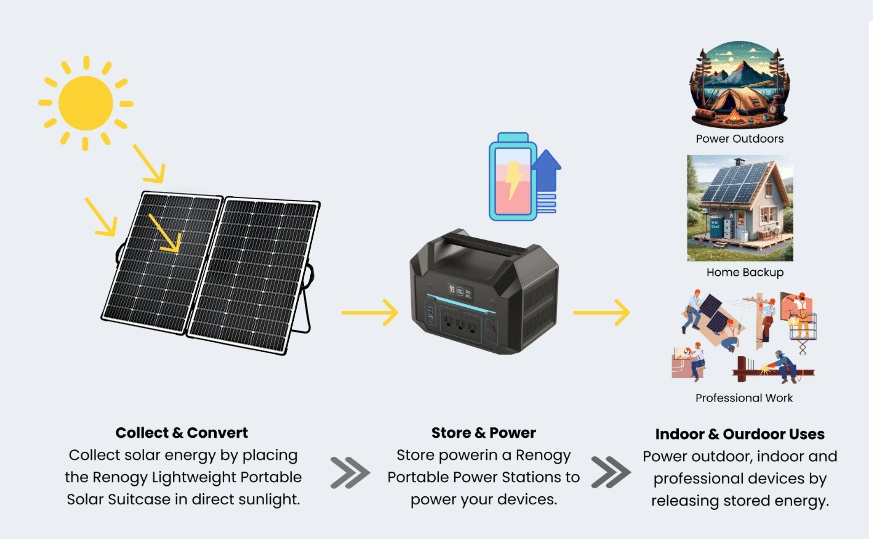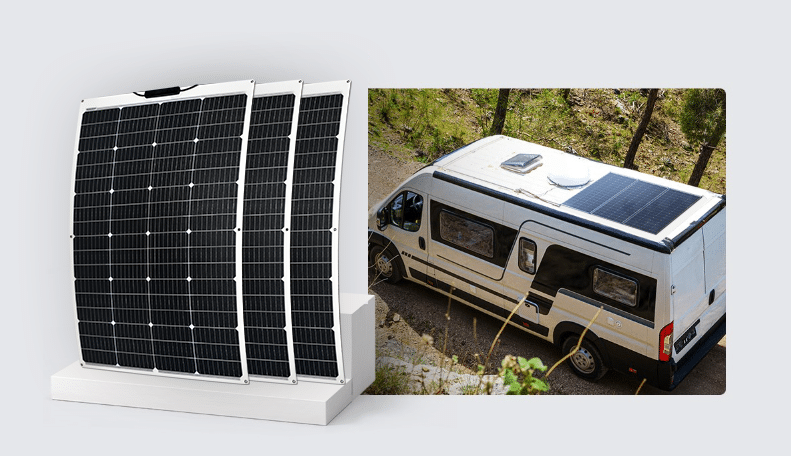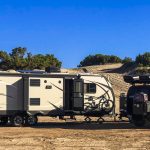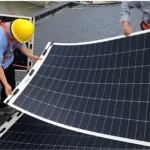If you are considering adopting renewable energy for your RV, solar power is an ideal choice that can efficiently power your air conditioning system. By using solar energy, you can reduce environmental pollution and significantly enhance your travel freedom. This article will explain in detail how RV solar panels work and whether they can meet the needs of an air conditioning system. Additionally, we will explore the value of installing a solar system and provide methods to optimize the combination of your RV Air Conditioning with Solar Panels, ensuring your journey is both comfortable and eco-friendly.
Components Needed to Run an RV Air Conditioner with Solar Power
Components of a Solar-Powered Air Conditioning System
When equipping an RV with a solar-powered air conditioner, each component plays a crucial role in efficiently harnessing solar energy. Let’s take a look at the various parts that make up the system.
Solar Panels
Your solar panels are crucial as they capture sunlight and convert it into usable energy. To maximize energy output, you need efficient solar panels, especially since air conditioners have high power demands. Typically, an RV air conditioner requires panels with a total output between 300 and 800 watts, depending on the BTU rating of the air conditioner and your expected usage.
Battery
This component stores the electricity generated by the solar panels. Different types of batteries can be used, such as lead-acid batteries, AGM (Absorbent Glass Mat) batteries, and lithium batteries. Lithium-ion batteries are preferred due to their longer lifespan and higher energy density. The size of the battery bank is typically measured in amp-hours (Ah) and should be adjusted according to the system’s wattage and the air conditioner’s current consumption.
Inverter
The inverter’s job is to convert the direct current (DC) produced by the solar panels and stored in the battery bank into alternating current (AC) that the air conditioner can use. Ensure that the inverter’s wattage matches or exceeds the wattage of your RV air conditioner. A soft start feature is very useful as it reduces the initial power draw when starting the air conditioner.
Charge Controller
The solar charge controller regulates the current from the solar panels to the battery bank, preventing the batteries from overcharging. This is a crucial safety feature that also prevents deep discharge, thereby maximizing the lifespan of the battery bank.
Air Conditioner
An RV air conditioner is equipped with a compressor that should have an appropriate BTU output to effectively cool your space. Solar-powered AC systems can work with traditional appliances or be specifically designed for solar applications. Consider devices with a soft start mechanism to reduce surge stress on the system.
Additional Components
In addition to the main components, your system may also include a distribution board for safe power distribution, various switches, and monitoring systems to track how much power the solar panels generate and how much power the air conditioner consumes.
How Does a Solar Generator Power an RV Air Conditioner
A solar generator can power an RV air conditioner by converting solar energy into usable electricity. The specific steps are as follows:
- Solar Panels Collect Solar Energy: Solar panels capture sunlight and convert it into direct current (DC).
- Power Regulation and Storage: A charge controller regulates the generated power and stores it in deep-cycle batteries for later use.
- Power Conversion: When the RV air conditioner needs to run, an inverter converts the stored DC power into alternating current (AC) to meet the demands of most RV air conditioners.

Challenges of Meeting High Power Demands for RV Air Conditioners
RV air conditioners typically require 1500-3500 watts of starting power and 500-1500 watts of running power. To meet these demands, a robust solar system is essential, which should include:
- Sufficient Solar Panel Capacity: Ensure there are enough panels to collect and convert ample power.
- Ample Battery Storage: Deep-cycle batteries can store enough power to ensure the air conditioner can run continuously when needed.
- Powerful Inverter: The inverter must efficiently convert DC power to AC power, ensuring the proper operation of the air conditioner.
Advantages of Choosing Sungold Flexible Solar panels
Sungold solar components offer a one-stop solution specifically designed for RV solar needs. Here are several key advantages of choosing Sungold solar kits:
- Comprehensive Solution: Sungold kits include all necessary components, from solar panels to battery storage and inverters.
- High Efficiency and Energy Saving: Energy-efficient air conditioning equipment combined with good energy-saving practices can significantly enhance system performance.
- Long-Term Investment Value: Although the initial cost is higher, the system provides off-grid freedom, reduces reliance on campsite electricity, and achieves eco-friendly cooling.
Choosing the Right Solar AC System for Your RV
Selecting the right solar power system is crucial for ensuring the proper operation of your RV air conditioner. To achieve this, you need to understand key parameters and accurately calculate your energy requirements. This process involves balancing available space, power needs, and the appropriate hardware investment.
Key Specifications
When evaluating a solar system to power an RV air conditioner, focus on the following key parameters:
- Cooling Capacity (BTU): The air conditioner’s cooling capacity is measured in BTUs (British Thermal Units). Typical RV air conditioners range from 11,000 to 15,000 BTU.
- Wattage: The output power of solar panels is measured in watts (W). The wattage of the panels you need should meet or exceed the power consumption of the air conditioner while it is running.
- Battery Storage: The capacity of the battery bank is usually measured in kilowatt-hours (kWh) and must be large enough to store the power generated by the solar panels.
- Space Utilization: The size of the RV roof limits the number of solar panels that can be installed. More panels mean more power, but space must be effectively managed.
Calculating Energy Requirements
Here are the steps to calculate the energy requirements for an RV air conditioner:
- Determine Air Conditioner Wattage (W): Check the air conditioner manual or nameplate to find its power consumption information, usually listed in watts.
- Calculate Daily Energy Consumption (Wh): Estimate the number of hours the air conditioner runs each day and multiply it by the wattage to get the daily watt-hours (Wh).
- Estimate System Requirements: The size of the solar panels and batteries should meet the daily watt-hour consumption, considering efficiency losses and potential power waste.
Example: Choosing a System for a 13,500 BTU RV Air Conditioner
Consider a 13,500 BTU RV air conditioner with a typical power consumption of about 1,500 watts:
- Daily Operation for 5 Hours: 1,500 watts * 5 hours = 7,500 watt-hours/day.
- Solar Panel Size: Assuming 5-6 hours of effective sunlight per day, the total wattage of the panels should meet the daily watt-hour requirement.
- Battery Capacity: Look for a battery bank with a capacity of at least 7,500 watt-hours, preferably more, to accommodate cloudy days or days with less sunlight.
Installation Process for Solar-Powered Air Conditioning in an RV
When installing a solar-powered air conditioner in an RV, you need to consider several key factors, such as the design of the solar panel array, sufficient wattage and current, and the safe connection of all components to the RV system. This is a multi-step process that requires attention to detail and safety.
System Configuration
1.Assess Your Energy Needs: Before starting, calculate the running and starting power of the air conditioner. This will help you determine the size of the solar panel array and batteries needed for your RV solar system.
Choose the Right Components:
- Solar Panels: Based on the required wattage
- Charge Controller: Effectively controls the charging process of the RV batteries
- RV Batteries: Store the power generated by the solar panels
- Inverter: Converts the DC power generated by the solar panels and batteries into AC power for the air conditioning system
Solar Panel Assembly
- Choose Mounts: Select suitable mounts for your RV roof to ensure stability and the optimal angle to the sun.
- Installation: Use the mounts to install the solar panels onto the roof of your RV. Ensure they are positioned to receive maximum sunlight and securely fastened to withstand the rigors of travel.
Wiring and Electrical Safety
- Electrical Connections: Connect the solar panels to the charge controller. Use properly rated cables to handle the expected current (amperes).
- Safety Precautions: Use fuses or circuit breakers near the battery bank to prevent overloading.
- Ensure Proper Insulation: Ensure all wiring is properly insulated and routed to prevent short circuits and protect the components from damage.
Connecting to the RV System
- Linking RV Batteries: Connect the charge controller to the RV batteries.
- Inverter Connection: Use sturdy cables to connect the inverter to the batteries, ensuring correct polarity.
- Integrating the Air Conditioner:
-Finally, connect the air conditioner to the inverter, using additional adapters if necessary.
-Test the system to ensure everything is functioning properly and the air conditioner is powered.
Pros and Cons of Using Solar Power for RV Air Conditioning
When considering using solar power for your RV air conditioner, it’s important to weigh the advantages and potential drawbacks.
Pros
- Renewable: Your solar system uses solar energy, making it a green and sustainable power source.
- Independence: You gain energy freedom and reduce reliance on grid power and generators.
- Cost Savings: Over time, solar power can save you money by reducing costs associated with traditional power sources.
Cons
- Initial Investment: The upfront cost of solar panels, batteries, and installation can be high.
- Space Requirements: Solar panels need sufficient space on your RV for installation.
- Weather Dependent: The system’s efficiency varies with weather conditions, and it performs less efficiently on cloudy days.
- Maintenance: While solar panels require relatively little maintenance, it is still an additional task to consider when maintaining your RV.
Despite the significant initial investment, solar panels offer long-term environmental benefits and potential savings. Just ensure you have enough space and are prepared for the initial costs.
Comfortable Travel: Sungold RV Flexible Solar Kits
Embark on a journey towards sustainable energy independence with Sungold RV flexible kits, designed to equip your recreational vehicle (RV) with an efficient solar solution. These kits feature innovative Sungold 200W 12V flexible monocrystalline solar panels, aimed at enhancing your travel experience while reducing environmental impact. Whether you are a weekend adventurer or a full-time nomad, these kits provide a reliable, efficient, and eco-friendly energy solution for your mobile lifestyle.

Final thoughts
Understanding how to power your RV air conditioner with sunlight can provide you with an eco-friendly cooling solution on any adventure. Utilizing solar energy not only keeps you comfortable without traditional power sources but also significantly reduces costs and environmental impact. By using efficient solar panels and compatible inverters, you can optimize energy conversion and continuously run your air conditioner even in remote areas.







